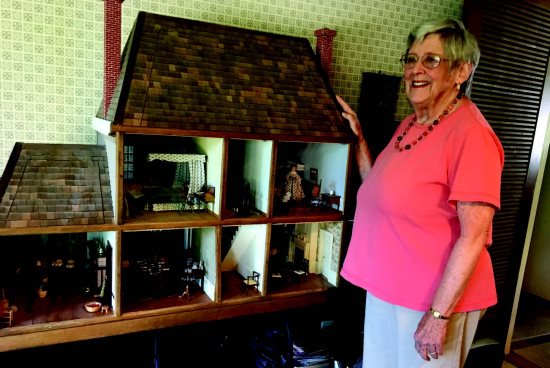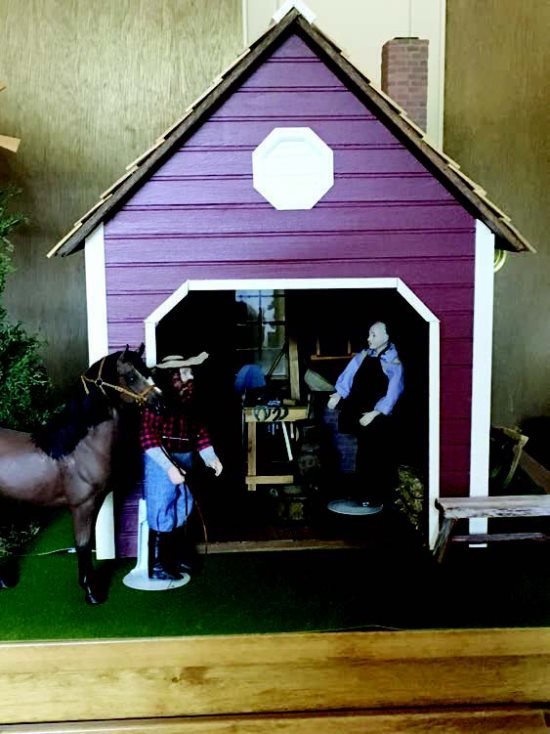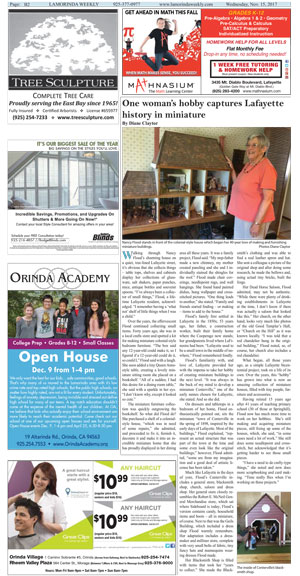| | Published November 15th, 2017
| One woman's hobby captures Lafayette history in miniature
| | | By Diane Claytor |  | | Nancy Flood stands in front of the colonial-style house which began her 40-year love of making and furnishing miniature buildings. Photos Diane Claytor |
Walking through Nancy Flood's charming house on a quiet, tree-lined Lafayette street, it's obvious that she collects things - table tops, shelves and cabinets display her collections of glassware, salt shakers, paper punches, mice, antique bottles and souvenir spoons. "I've always been a collector of small things," Flood, a lifetime Lafayette resident, acknowledged. "I remember having a 'what not' shelf of little things when I was a child."
 Over the years, the effervescent Flood continued collecting small items. Forty years ago, she was in a local crafts store and spotted a kit for making miniature colonial-style bedroom furniture. "The box said any 12-year-old could make it, so I figured if a 12-year-old could do it, so could I," Flood said with a laugh. She soon added a tiny Queen Anne-style table, creating a lovely miniature sitting room she placed on a bookshelf. "All of a sudden, I had this desire for a dining room table," she said with a sparkle in her eye. "I don't know why, except it looked so cute."
Over the years, the effervescent Flood continued collecting small items. Forty years ago, she was in a local crafts store and spotted a kit for making miniature colonial-style bedroom furniture. "The box said any 12-year-old could make it, so I figured if a 12-year-old could do it, so could I," Flood said with a laugh. She soon added a tiny Queen Anne-style table, creating a lovely miniature sitting room she placed on a bookshelf. "All of a sudden, I had this desire for a dining room table," she said with a sparkle in her eye. "I don't know why, except it looked so cute."
 The miniature furniture collection was quickly outgrowing the bookshelf. So what did Flood do? She purchased a shell of a colonial-style house, "which was in need of some repairs," she admitted, and proceeded to fix it, furnish it, decorate it and make it into an incredible miniature home that she has proudly displayed in her dining area all these years. It was a family project, Flood said. "My step-father made a new chimney, my mother created paneling and she and I individually stained the shingles for the roof." Flood made chair coverings, needlepoint rugs, and wall hangings. She found hand painted dishes, hung wallpaper and cross-stitched pictures. "One thing leads to another," she stated. "Family and friends started finding - or making - items to add to the house."
The miniature furniture collection was quickly outgrowing the bookshelf. So what did Flood do? She purchased a shell of a colonial-style house, "which was in need of some repairs," she admitted, and proceeded to fix it, furnish it, decorate it and make it into an incredible miniature home that she has proudly displayed in her dining area all these years. It was a family project, Flood said. "My step-father made a new chimney, my mother created paneling and she and I individually stained the shingles for the roof." Flood made chair coverings, needlepoint rugs, and wall hangings. She found hand painted dishes, hung wallpaper and cross-stitched pictures. "One thing leads to another," she stated. "Family and friends started finding - or making - items to add to the house."
 Flood's family first settled in Lafayette in the 1850s; 53 years ago, her father, a construction worker, built their family home where the Cooperage now stands; her grandparents lived where LaFinestra had been. "Lafayette used to be a small town in the middle of nowhere," Flood remembered fondly.
Flood's family first settled in Lafayette in the 1850s; 53 years ago, her father, a construction worker, built their family home where the Cooperage now stands; her grandparents lived where LaFinestra had been. "Lafayette used to be a small town in the middle of nowhere," Flood remembered fondly.
 Flood's familiarity with, and love of, Lafayette provided her with the impetus to take her hobby of creating miniature buildings to the next level. "It was always in the back of my mind to develop a miniature Centerville," one of the early names chosen for Lafayette, she stated. And so she did.
Flood's familiarity with, and love of, Lafayette provided her with the impetus to take her hobby of creating miniature buildings to the next level. "It was always in the back of my mind to develop a miniature Centerville," one of the early names chosen for Lafayette, she stated. And so she did.
 On dressers and tabletops in a bedroom of her home, Flood enthusiastically pointed out, sits the miniature "town of Centerville in the spring of 1898, inspired by the early days of Lafayette. Most of the buildings," Flood explained, "represent an actual structure that was part of the town at the time and some even look like the original buildings;" however, Flood admitted, "some are from my imagination and a good deal of artistic license has been taken."
On dressers and tabletops in a bedroom of her home, Flood enthusiastically pointed out, sits the miniature "town of Centerville in the spring of 1898, inspired by the early days of Lafayette. Most of the buildings," Flood explained, "represent an actual structure that was part of the town at the time and some even look like the original buildings;" however, Flood admitted, "some are from my imagination and a good deal of artistic license has been taken."
 Much like Lafayette in the days of yore, Flood's Centerville includes a general store, blacksmith shop, church, saloon and dress shop. Her general store closely resembles the Robert E. McNeil General Merchandise store, which sat where Sideboard is today; Flood's version contains candy, household items and boots - all in miniature, of course. Next to that was the Geils Building, which included a dress shop Flood warmly remembers. Her adaptation includes a dressmaker and milliner store, complete with very small bolts of fabric, tiny fancy hats and mannequins wearing dresses Flood made.
Much like Lafayette in the days of yore, Flood's Centerville includes a general store, blacksmith shop, church, saloon and dress shop. Her general store closely resembles the Robert E. McNeil General Merchandise store, which sat where Sideboard is today; Flood's version contains candy, household items and boots - all in miniature, of course. Next to that was the Geils Building, which included a dress shop Flood warmly remembers. Her adaptation includes a dressmaker and milliner store, complete with very small bolts of fabric, tiny fancy hats and mannequins wearing dresses Flood made.
 Her Blacksmith Shop is filled with items that took her "years to collect." She made the Blacksmith's clothing and was able to find a real leather apron and hat. She sent a colleague a picture of the original shop and after doing some research, he made the bellows and, using actual tiny bricks, built the forge.
Her Blacksmith Shop is filled with items that took her "years to collect." She made the Blacksmith's clothing and was able to find a real leather apron and hat. She sent a colleague a picture of the original shop and after doing some research, he made the bellows and, using actual tiny bricks, built the forge.
 Her Dead Horse Saloon, Flood admitted, may not be authentic. "While there were plenty of drinking establishments in Lafayette at the time, I don't know if there was actually a saloon that looked like this." Her church, on the other hand, looks very much like photos of the old Good Templar's Hall, or "Church on the Hill" as it was known locally. "I was told that a red chandelier hung in the original building," Flood noted, so, of course, her church also includes a red chandelier.
Her Dead Horse Saloon, Flood admitted, may not be authentic. "While there were plenty of drinking establishments in Lafayette at the time, I don't know if there was actually a saloon that looked like this." Her church, on the other hand, looks very much like photos of the old Good Templar's Hall, or "Church on the Hill" as it was known locally. "I was told that a red chandelier hung in the original building," Flood noted, so, of course, her church also includes a red chandelier.
 What began, all those years ago, as a simple Lafayette bicentennial project, took on a life of its own. Over the years, this "hobby" has grown into what is now an amazing collection of miniature houses, filled with tiny people, furniture and accessories.
What began, all those years ago, as a simple Lafayette bicentennial project, took on a life of its own. Over the years, this "hobby" has grown into what is now an amazing collection of miniature houses, filled with tiny people, furniture and accessories.
 Having retired 15 years ago after 41 years of teaching primary school (30 of those at Springhill), Flood now has much more time to work on her hobbies. She's still making and acquiring miniature pieces, still fixing up some of the houses, which, she said, "in some cases need a lot of work." She still does some needlepoint and cross-stitch, but acknowledged that it's getting harder to see those small pieces.
Having retired 15 years ago after 41 years of teaching primary school (30 of those at Springhill), Flood now has much more time to work on her hobbies. She's still making and acquiring miniature pieces, still fixing up some of the houses, which, she said, "in some cases need a lot of work." She still does some needlepoint and cross-stitch, but acknowledged that it's getting harder to see those small pieces.
 "I have a need to do crafty-type things," she noted and now does more scrapbooking and card making. "Time really flies when I'm working on these projects."
"I have a need to do crafty-type things," she noted and now does more scrapbooking and card making. "Time really flies when I'm working on these projects."


|
 | | The inside of Centerville's blacksmith shop. | | | | | | | | | | | |




